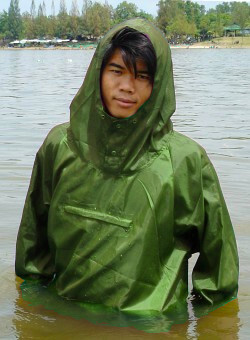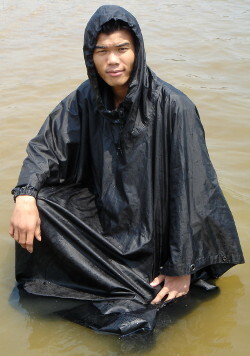Wetland Wildlife Watching
A wetland is a place where the land is partially covered by water, either salt, fresh or somewhere in between. Wetlands include marshes and ponds, the edge of a lake or ocean, the delta at the mouth of a river, and low-lying areas that frequently flood.
When it Rains, Animals use Umbrellas
Being caught in the rain is often fun, but small animals can get bothered by the rain it seems. The raindrops are relatively large for them, so they seek shelter, and creatively use leaves, flowers and mushrooms as make-do umbrellas.
See More in the Rain
You’ll see greenery greener than usual when it rains. The plants will be teeming with life from the downpour and drizzle, giving you the chance to see them in their fully-nourished glory. The gorgeous surroundings give you a sense of calm serenity. Wildlife will be on full display in the rain. Unlike humans, birds seem to love the wet weather. It brings insects up from the ground, providing a feeding-frenzy for the birds on the surface.
Hiking in rainy wet weather may afford you some of the best scenery Mother Nature has to offer.
When it rains you can experience nature at its gentle side.
The ground is softer, the air smells fresh and full of fragrances.
Enjoy listening to the rainfall, watch the drops run off your rain cape,
and the feeling of the rain peacefully soaking you.
Biodiversity
Wetlands teem with biodiversity, providing homes for many endangered species. They have been compared to rainforests and coral reefs because of the large amount of plants and animals they support. They are part of our natural infrastructure, providing essential protection against environmental issues like flooding, drought and pollution.
One in ten of endangered species need wetlands to survive. With many invertebrates, rich in plants and a haven for mammals, wetlands offer an unforgettable experience. These beautiful areas are a vital part of our natural world. The lives of animals, plants and people depend on their health.
The best time is in summer after the breeding season,
so you don't disturb the wildlife.
While you walk or wade along the shore slowly,
explore the marvellous marine life in a submerged part of the forest.
Hiking through constant rain can be quite fun even though you get all wet.
If you're willing to get completely drenched you'll have a chance to see frogs and other wetland animals in their mostly untouched habitat.
Woodland Lakes
The serene tranquility of a woodland lake is the perfect place to unwind. On rainy days you probably have the place to yourself.
Wildlife watching offers a nice blend of woodland trekking and open water swimming. Whenever you come a nice sheltered beach in the forest, go for a relaxing swim before you continue with your walk.
Leave nothing behind on any beach.
Swimming along the shore from on beach to the next beach
makes good cross training between, walking, swimming, and running.
Amphibious Trekking
Amphibious Trekking is the most direct and minimalistic way of exploring wetland areas. It consists in alternating between traditional trekking and open water swimming.
Splashing through puddles, creek crossing, and getting your clothes wet are all part of the joy of hiking in varied terrain. Listen to the sound of raindrops hitting the leaves and trees, coupled with the almost hypnotic sound of the rain bouncing off your hood, could be enough to make anyone want to go hiking in the rain.
If you wish to join the ranks of wetland wildlife watchers,
there's no better time than the present to take the plunge, or at least dip your toes in.
Observe wildlife while swimming along the shore.
But wait.
Where should you go?
How do you even find wildlife?
If you're a novice to watching wildlife from the water,
this hiking section will give you the tools you need to venture into the wetlands with confidence.
Gentle Nature Exploration
Swimming in lakes and rivers where boats are not allowed is great fun as you can explore nature from the water. Find a nice beach or spot where you can easily wade in. The serene tranquility of a lake is the perfect place to unwind. On rainy days you probably have the place to yourself.
Lakes provide an ideal hiking area. The landscape is varied, trails run along the shore, and you can go for a swim whenever you like.
Blend into the Background
For nature exploration you want to blend into the background so you don't upset the wildlife. Wear clothes dark colours or camouflage patterns that are easy to swim in but keep you warm and protect you from cuts and scrapes.
A poncho, combined with nylon or cargo pants, hides your shape and covers your whole body. Put the hood up to hide your head. A fleece pullover underneath keeps you warm, as you won't be moving as fast as on usual open water swims.
When you go into the water in these clothes and move slowly,
you look like something that just floats by, not like a predator.
Protect Native Species
Invasive non-native species of wildlife can hitchhike on equipment, footwear, clothing and boats. You may inadvertently spread the aliens even if you just go for a swim or paddle!
Every time you leave any water such as a river or lake: Check - Clean - Dry
Check your equipment and clothing for living organisms. Pay particular attention to damp or hard to inspect areas, like pockets, hoods, and shoes.
Clean and wash all equipment, footwear and clothes thoroughly.
If you do come across any organisms, leave them at the water body where you found them.
Dry all equipment and clothing. Some species can live for many days in damp conditions.
Reader Comments
Dawn Patrol
by Sergey, from Tallinn, EstoniaI’m often asked how I get my wildlife photo shots. Most of my photos of deer are taken from the edge of the woods looking out. I normally arrive just before sunrise when the deer are grazing peacefully in the open. It can also be a time for great light and mist.
Most bird photos I take on my early morning trips to the lake. I put a waterproof camera on a tripod and place it near the reed beds along the shore. I sit chest deep in shallow water to appear smaller, dressed from top to toe in camouflage clothes.
The trick is to blend into the surroundings. Contrasting shades and natural patterns of camouflage clothes break up the shape and outline of the photographer. Deer and other wildlife see in black and white, so contrasting shades are the real key. Camouflage with little contrast looks like a block of colour at a distance, so the bolder the better.
For all wetland trips I wear warm fleece clothes under a hooded camo suit, with robust socks and boots.
This outfit keeps me warm and feels good when swimming, so I wear it whenever I go into the water.
Anybody looking would think I was a bit strange, but luckily the camouflage works well.
Lake Wildlife
by Lee Fung from Chiang Mai, ThailandThe lake near my home is full of natural wonders. I often go out on rainy days when more wildlife can be seen than on sunny days. Walking in the rain feels so good when I get wet. The moist air smells so beautiful.
On many days the rain clouds build up over the lake by the mountain and I quickly put on my wildlife watching swim clothes: tee-shirt, rain pants, anorak and poncho. They work best in the hot climate here and feel nice in the water and on land. I really enjoy swimming in these clothes.
As it begins to rain I go to the lake and watch the weather. If it is not a thunderstorm, I go into the water and swim along the forest shore. There are many little animals I see in the water and by the waterside.
After the rain I walk home and take a the shower in my clothes to rinse out the lake stuff which could become smelly. This also avoids taking lifeforms into other lakes where they don't belong.

I always swim in a sun protection anorak or poncho.

This wildlife watching poncho hides my shape in the water.